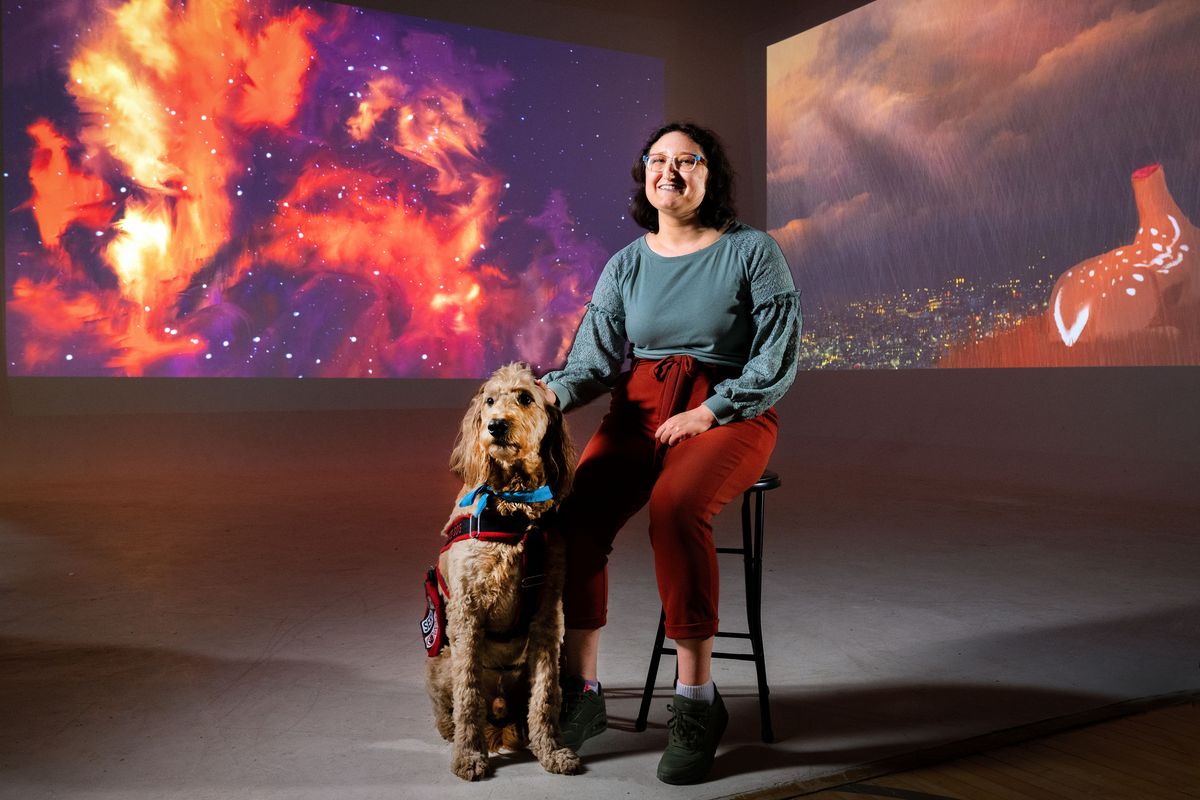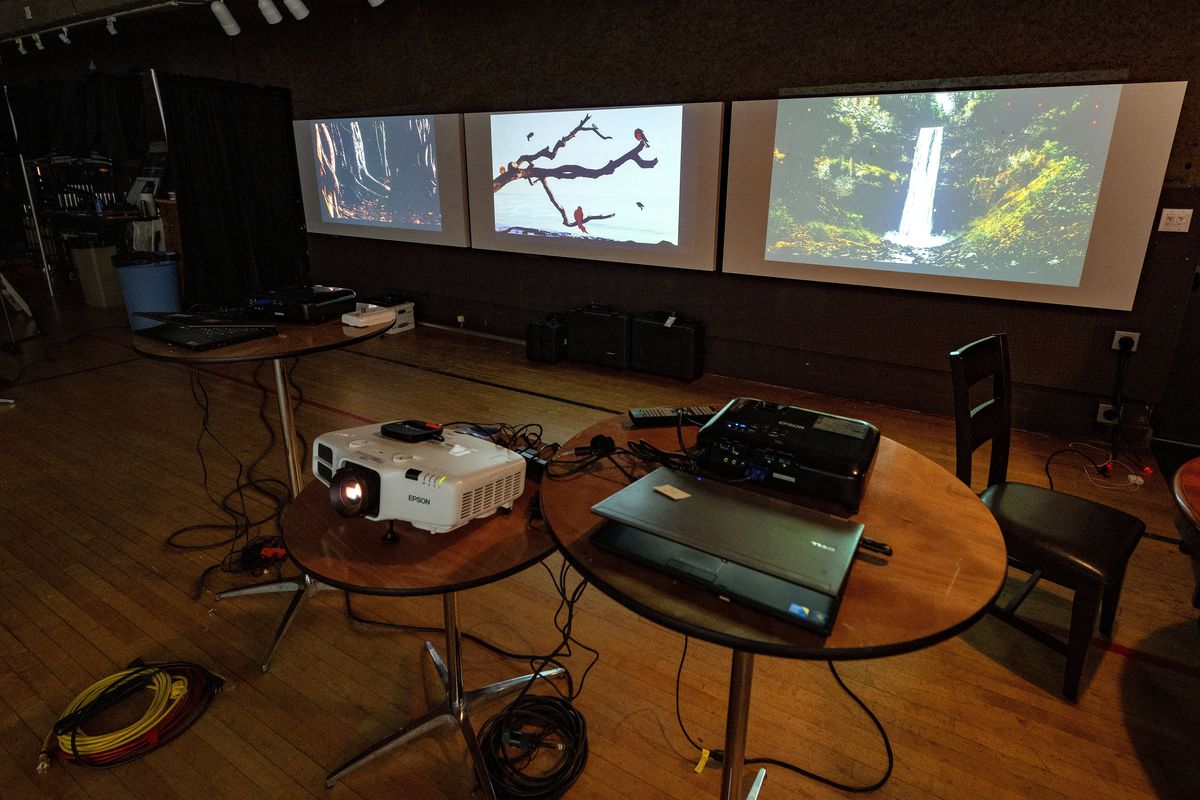‘The World Between’: Emilija Blake animates her disabilties
Emilija Blake, with her guide dog Kasper, sits in front of her projected digital artworks as part to her show, “The World Between.” The multimedia presentation focuses primarily on the unique challenges of life as a disabled person. The show opens 6 to 9 p.m. Friday and runs 11 a.m.-3 p.m. Saturday and Sunday. (COLIN MULVANY/THE SPOKESMAN-REVIEW)
Resting atop a hill, a headless deer gazes down at a city. Without eyes, the deer manages to appear sentinel. This was artist Emilija Blake’s first creature, artwork that serves as a stand-in for her disabilities and symptoms. The deer is disassociation, “feeling like you’re outside of your body, existing somewhere else, like your head is in the clouds,” Blake said, sitting with her mom, Taffy Hunter, in Hamilton Studio, while Don Hamilton, Hamilton Studio co-owner, busied himself setting up projectors, and her service dog, Kasper, a goldendoodle, stayed by her side.
Blake, who has been an artist-in-residence at Hamilton Studio for about nine months, has created a world for the deer and other creatures to live, and she’s invited the public to explore that world. “The World Between,” a multimedia art installation, opens 6 p.m. Friday at Hamilton Studio. There will also be showings Saturday and Sunday from 11 a.m.-3 p.m.
“She just comes in and she’s quiet, keeps to herself, works on her keyboard,” Hamilton said. “But this is her medium and the idea of filling this pretty good-sized space with her video, it’s intriguing and it’s a thing and I hope people come out and see it.”
Her artwork will fill the space; 10 projectors will be set up, bathing the walls in Blake’s animations.
“I’ve been wanting to share something like this for a long time because it creates a safe space for people to talk about disabilities in a new way,” Blake said. “I think it can also help like people like me figure out where they are in their world.”
Blake has several diagnoses, but she said her core diagnosis is complex post-traumatic stress disorder, which stems from trauma. She also has general anxiety, social anxiety, depression and complex regional pain syndrome, among others.
“I think disabilities are not talked about enough in a positive way,” Blake said. “So, I want to be able to show people that disabilities don’t have to always be negative, they can just be.”
Blake expressed a fondness for her creatures representing her disabilities.
“I love them,” Blake said. “They’re like little parts of me that I’ve turned into their own little being, so I’m very fond of them.”
Turning her disabilities and symptoms into something tangible has been healing, she said.
“It’s not just in my head, and I think it also like helps other people see that it’s not in my head because some people be like, ‘You’re not actually disabled, you just need to drink water,’ ” Blake said.
In 2023, Blake graduated from Eastern Washington University with a bachelor’s in fine arts, with a focus on digital art and illustration as well as a minor in art history.
“No one else had really ever been interested in doing animation, because it’s really hard to do and it just takes forever,” Blake said of her choice to pursue digital art and animation. “I was like, ‘This looks really fun!’ ”
She creates mostly Adobe programs, like Fresco, Animate and Photoshop, but she also uses Procreate, as well as basic video editing software to extend the animations. Part of her desire to pursue digital art was because she found herself falling in love with every art medium: oil, pastel, acrylic, watercolor, pencil and printmaking.
“It didn’t matter what it was, that’s what she wanted to do,” Hunter said.
Blake finds that digital allows her to pursue it all, but her first love was, in fact, animation. Pencil in hand, Blake drew Rudolph over and over as a young child, yearning to capture the spark of animation through repeated drawings.
“When did I start holding a pencil?” Blake asked Hunter, who answered 2. “When I was 2, I wanted to be an animator, and that never went away,” Blake said.
The world Blake creates is immersive and uncomfortable by design. When asked if she wants the audience to have an unsettling response to her work, she answered before the question was completed: Yes. The point is for the viewer to feel in their body something close to how Blake feels.
Blake’s Latvian heritage, which is deeply rooted in nature, also influences her art. Her deer is based off Latvian deer, she said. To identify the different creatures in their habitat, Blake also created a “field guide” for the event, which includes sketches and catalogs the creatures’ sizes, diet and level of threat.
Blake finds it much easier to be around other people with disabilities. One the places she makes that connection is when she’s taking paratransit.
“It’s a safe space, so people are free to be disabled,” Blake said. “I’ve definitely not felt judged or anything.”
Blake’s vision is to one day allow other people with disabilities to contribute to her world, adding their own creatures. Though she hasn’t figured out the logistics, she would like to create a website that makes this possible.
“My future website is like having everything like join the ecosystem and we just create an actual world with everybody in it,” Blake said.

